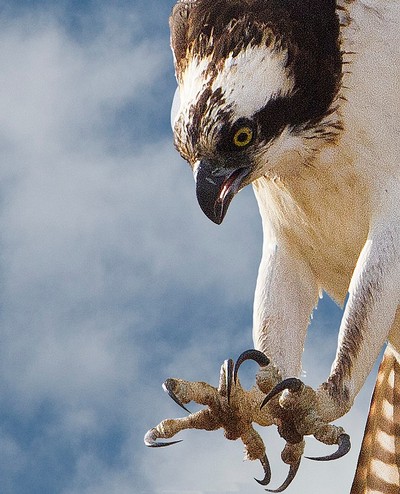Osprey - Sörmland's province animal
Published by Stefanie Schlosser in Province symbols · 6 January 2022
Tags: osprey, fishhawk, provincesymbol
Tags: osprey, fishhawk, provincesymbol
The Swedish landscape Sörmland not only has a landscape flower (see blog post about the white water lily) but as well a landscape animal and bird, which is both represented by the osprey, also known as fish hawk.
This predator bird is found all around the world, on every continent except Antarctica. In Sweden it occurs widespread, except on the island of Gotland. Preferably ospreys breed aside freshwater lakes and rivers, however, they are found along the Baltic coast as well. Sörmland has countless lakes and provides suitable habitat for fish hawks in many places. Around 40% of the European osprey population breeds in Sweden! They need big trees, mostly old pines, close to water. It is therefore important to protect these kind of habitats as for example around lake Båven and the Marvikarna lakes in Sörmland.
Fish hawks, as the name suggests, eat mostly fish. In fact, their diet contains of about 99% fish.
Swedish ospreys spend winter time in Africa and come back between March and April. Interestingly, females leave earlier than males, even though the couples stay together for their entire life. On their long trips, they can make around 260-280 km per day, with a maximum of 460 km observed. In total, ospreys travel up to 6700 km between their breeding grounds in Sweden and their winter residences in Africa.
Ospreys not only are monogamous but as well return to their “home” every year. In many cases they even use the same nest again, even though they don’t travel together and arrive at different times. Before laying eggs, the old nest gets fixed. Like this, it keeps on growing and can reach up to three meters in diameter after being used for some years.
It was the well-known Swedish botanist, zoologist, taxonomist and physician Carl von Linné who first described the osprey Falco haliaetus in the 18th century. Today, taxonomists don’t agree on the systematical classification. Because of some unique characteristics like nostrils that can be closed when diving and an outer toe that can be angled backwards to get better hold of the fish while transporting it to the nest, the fish hawk (today Pandion haliaetus) is commonly classified as the only species in the genus Pandion, which itself is the only genus in the family Pandionidae.
The osprey thereby is the only species in an entire taxonomical family, which is quite special.

Fish hawks communicate in several ways. Not only have they eight distinctive vocalizations but as well 11 physical movements to express themselves, provide information and to attract mating partners. During the so-called “sky-dance”, male ospreys feed the females, bring building material for the nest and perform different movements and flying techniques in order to impress their desired female.
As other prey birds, ospreys were highly affected by the environmental toxin DDT in the 1950s and 1960s. DDT affected the bird’s calcium metabolism which led to eggs with thin shells or even infertility. Since DDT was banned in the 1970s the osprey’s populations recovered.
Have you already seen ospreys around Sweden or in other parts of the world? You’re welcome to share your experience in the comments below!
Post sources:
- Osprey Wikipedia: https://en.wikipedia.org/wiki/Osprey
- fågeln.se: https://fageln.se/art/fiskgjuse.aspx
- Sörmlands Ornitologerna: https://sormlandsornitologerna.se/rrk/fiskgjuse.html
- treehugger.com: https://www.treehugger.com/fascinating-facts-about-the-odd-but-awesome-osprey-4864541
- Carl Linneaus Wikipedia: https://en.wikipedia.org/wiki/Carl_Linnaeus
There are no reviews yet.